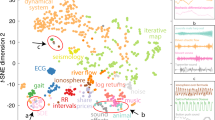Abstract
In this paper, we consider the challenging problem of finding shared information in multiple data streams simultaneously. The standard statistical method for doing this is the well-known canonical correlation analysis (CCA) approach. We begin by developing an online version of the CCA and apply it to reservoirs of an echo state network in order to capture shared temporal information in two data streams. We further develop the proposed method by forcing it to ignore shared information that is created from static values using derivative information. We finally develop a novel multi-set CCA method which can identify shared information in more than two data streams simultaneously. The comparative effectiveness of the proposed methods is illustrated using artificial and real benchmark datasets.




Similar content being viewed by others
References
Akaho S, kernal A (2006) method for canonical correlation analysis. In: Proceedings of the international meeting of the Psychometric Society (IMPS2001), Springer (arXiv preprint cs/0609071)
BieBmann F, Meinecke FC, Gretton A, Rauch A, Rainer G, Logothetis NK, Muller KR (2010) Temporal kernal CCA and its application in multimodal neuronal data analysis. Mach Learn 79(1–2):5–27
Cambria E, Fu J, Bisio F, Poria S (2015) AffectiveSpace2: enabling affective intuition for concept-level sentiment analysis. In: AAAI, pp 508–514
Cambria E, Gastaldo P, Bisio F, Zunino R (2015) An ELM-based model for affective analogical reasoning. Neurocomputing 149(Part A):443–455
Friman O, Borga M, Lundberg P, Knutsson H (2002) Exploratory fmri analysis by autocorrelation maximization. Neuroimage 16(2):454–464
Gastaldo P, Zunino R, Cambria E, Decherchi S (2013) Combining elm with random projections. IEEE Intell Syst 28(6):46–48
Gou Z, Fyfe C (2001) A family of networks which perform canonical correlation analysis. Int J Knowl Based Intell Eng Syst 5(2):76–82
Gou Z, Fyfe C (2003) A canonical correlation neural network for multicollinearity and functional data. Neural Netw 17(2):285–293
Gros C (2009) Cognitive computation with autonomously active neural networks: an emerging field. Cognit Comput 1(1):77
Hardoon DR, Szedmak S, Shawe-Taylor J (2004) Canonical correlation analysis: an overview with application to learning methods. Neural Comput 16(12):2639–2664
Hotelling H (1936) Relations between two sets of variates. Biometrika 28(3/4):321–377
Huang GB (2014) An insight into extreme learning machines: random neurons, random features and kernels. Cognit Comput 6(3):376
Kettenring JR (1971) Canonical analysis of several sets of variables. Biometrika 58(3):433
Lai PL, Fyfe C (1999) A neural implementation of canonical correlation analysis. Neural Netw 12(10):1391–1397
Lai PL, Fyfe C (2001) Kernel and nonlinear canonical correlation analysis. Int J Neural Syst 10(5):365–377
LeCun Y, Cortes C (1998) The MNIST database of handwritten digits. The dataset is available at http://yann.lecun.com/exdb/mnist
Lemire D (2009) Faster retrieval with a two-pass dynamic-time-warping lower bound. Pattern Recognit 42(9):2169
Lukosevicius M, Jaeger H (2009) Reservoir computing approaches to recurrent neural network training. Comput Sci Rev 3(3):127–149
Malik ZK, Hussain A, Wu J (2014) Novel biologically inspired approaches to extracting online information from temporal data. Cognit Comput 6(3):1–13
Malik ZK, Hussain A, Wu J (2016) An online generalized eigenvalue version of Laplacian eigenmap for visual big data. Neurocomputing 173(2):127–136
Malik ZK, Hussain A, Wu QJ (2016) Multilayered echo state machine: a novel architecture and algorithm. IEEE Trans Cybern PP(99):1–14
Mardia KV, Kent JT, Bibby JM (1980) Multivariate analysis. Academic Press, Cambridge
Nielsen AA (2002) Multi-set canonical correlations analysis and multispectral, truely multitemporal remote sensing data. IEEE Trans Image Process 11(3):293
Poria S, Gelbukh A, Cambria E, Hussain A, Huang GB (2014) Emosenticspace: a novel framework for affective common-sense reasoning. Knowl Based Syst 69:108–123. doi:10.1016/j.knosys.2014.06.011
Schrauwen B, Verstraeten D, Van Campenhout J (2007) An overview of reservoir computing: theory, application and implementation. In: Proceedings of the 15th European symposium on artificial neural networks, pp 471–482
Steil JJ (2007) Online reservoir adaptation by intrinsic plasticity for backpropagation-decorrelation and echo state learning. Neural Netw 20(3):353–364
Via J, Santamaria I, Perez J (2007) A learning algorithm for adaptive canonical correlation analysis of several data sets. Neural Netw 20(1):139–152
Wang X, Crowe M, Fyfe C (2012) Dual stream data exploration. Int J Data Min Model Manag 4(2):188–202
Wiskott L, Sejnowski TJ (2002) Slow feature analysis: unsupervised learning of invariances. Neural Comput 14(4):715–770
Wollmer M, Eyben F, Graves A, Schuller B, Rigoll G (2010) Bidirectional lstm networks for context-sensitive keyword detection in a cognitive virtual agent framework. Cognit Comput 2(3):180
Yang Y, Wu QMJ, Wang Y, Zeeshan KM, Lin X, Yuan X (2014) Data partition learning with multiple extreme learning machines. IEEE Trans Cybern. PP(99):18–20. doi:10.1109/TCYB.2014.2352594
Yger F, Berar M, Gasso G, Rakotomamonjy A (2012) Adaptive canonical correlation analysis based on matrix manifolds. In: Proceedings of the international conference on machine learning. New york, NY, ACM
Zeck G, Bethge M, Macke JH (2008) Receptive fields without spike-triggering. In: Platt JC, Koller D, Singer Y, Roweis ST (eds) Advances in neural information processing systems 20. Curran Associates, Inc, pp 969–976
Zhang Q, Leung YW (2000) A class of learning algorithms for principal component analysis and minor component analysis. IEEE Trans Neural Netw 11(2):200–204
Acknowledgements
The first author is grateful to Professor Colin Fyfe, formerly with the University of The West of Scotland, for his insightful suggestions which helped improve the writing of this paper. This work of Zeeshan Malik was supported by University of The Punjab, Lahore, Pakistan, as part of the Overseas Scholarship for his Doctoral Studies in the University of Stirling, UK.
Author information
Authors and Affiliations
Corresponding author
Rights and permissions
About this article
Cite this article
Malik, Z.K., Hussain, A. & Wu, Q.M.J. Extracting online information from dual and multiple data streams. Neural Comput & Applic 30, 87–98 (2018). https://doi.org/10.1007/s00521-016-2647-3
Received:
Accepted:
Published:
Issue Date:
DOI: https://doi.org/10.1007/s00521-016-2647-3




